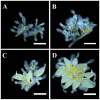An invasive whitefly feeding on a virus-infected plant increased its egg production and realized fecundity
- PMID: 20676356
- PMCID: PMC2911204
- DOI: 10.1371/journal.pone.0011713
An invasive whitefly feeding on a virus-infected plant increased its egg production and realized fecundity
Abstract
Background: Plant-pathogenic begomoviruses have a complex association with their insect vectors. The interactions of begomoviruses and reproduction of their vectors are poorly understood. Bemisia tabaci is known to transmit many begomoviruses, and the spread of B. tabaci, especially the B and Q 'biotypes', has been accompanied by the epidemics of begomoviruses. One of these identified disease-causing agents was Tomato yellow leaf curl China virus (TYLCCNV).
Methodology/principal findings: In this study, we compared the egg production and realized fecundity of two 'biotypes' or putative species of the whitefly B. tabaci, including the alien invasive B and the indigenous ZHJ1 from Zhejiang, China, feeding on either healthy or TYLCCNV-infected tobacco plants. The ovary of the whitefly was composed of 12-22 telotrophic ovarioles. According to the morphology of the oocytes and level of yolk content, oocytes in ovarioles were divided into four developmental phases (I-IV). Significantly higher proportion of immature oocytes (phase II, III) and mature oocytes (phase IV) was observed in ovary of females that fed on TYLCCNV-infected tobacco compared to that on healthy plants. Moreover, there was significant increase of eggs laid of B whitefly that fed on TYLCCNV-infected tobacco plants during the early developmental stages. In contrast, the proportion of oocytes of different developmental phases and eggs laid had no significant differences between ZHJ1 whiteflies feeding on TYLCCNV-infected and non-infected host plants.
Conclusions/significance: The invasive B whitefly benefits from feeding on a begomovirus-infected plant through increased egg production and realized fecundity.
Conflict of interest statement
Figures







References
-
- Zhou XP, Xie Y, Tao XR, Zhang ZK, Li ZH. Characterization of DNA beta associated with begomoviruses in China and evidence for co-evolution with their cognate viral DNA-A. J Gen Virol. 2003;84:237–247. - PubMed
-
- Liu SS, De Barro PJ, Xu J, Luan JB, Zang LS, et al. Asymmetric mating interactions drive widespread invasion and displacement in a whitefly. Science. 2007;318:1769–1172. - PubMed
-
- Liu J, Zhao H, Jiang K, Zhou XP, Liu SS. Differential indirect effects of two plant viruses on an invasive and an indigenous whitefly vector: implications for competitive displacement. Annals Appl Biol. 2009;155:439–448.
-
- Colvin J, Omongo CA, Govindappa MR, Stevenson PC, Maruthi MN. Host plant viral infection effects on arthropod-vector population growth, development and behavior: management and epidemiological implications. Adv Virol Res. 2006;67:419–452. - PubMed
-
- Stout MJ, Thaler JS, Thomma BPHJ. Plant-mediated interactions between pathogenic microorganisms and herbivorous arthropods. Annu Rev Entomol. 2006;51:663–689. - PubMed
Publication types
MeSH terms
LinkOut - more resources
Full Text Sources

